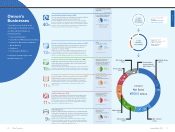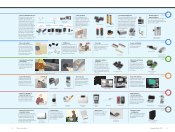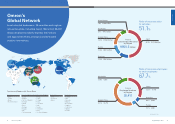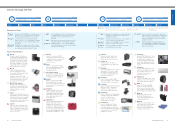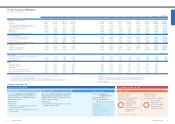Omron 2013 Annual Report Download - page 17
Download and view the complete annual report
Please find page 17 of the 2013 Omron annual report below. You can navigate through the pages in the report by either clicking on the pages listed below, or by using the keyword search tool below to find specific information within the annual report.
30 Omron Corporation Integrated Report 2013 31
Where We're Headed
Operations Well Established
in Each Country
Industrial Automation Business (IAB) currently
operates out of more than 160 bases in more than
40 countries.
IAB was quick to expand operations into Asia, a
move that was partially based on geographic con-
siderations. Over half of the world’s population is
concentrated in this region, as emphasized by the
presence of such “populous giants” as China and
India, which boast the world’s fi rst and second
largest populations respectively, as well as by the
ASEAN countries, which collectively represent the
third largest population. Realizing the great poten-
tial for automation to contribute to the development
of Asia, we were not hesitant in fi rmly establishing
operations in this region, which we then utilized to
continue our ongoing pursuit to further the advance
of automation.
We began developing operations in China imme-
diately after Sino-Japan trade relations were re-
stored in 1972, and Omron founder Kazuma Tateishi
proceeded to deepen relationships with this coun-
try thereafter. In the 1980s, we began outsourcing
production to China, helping introduce our accumu-
lated Japanese production technologies into this
country. At the same time, we established sales
outlets in major operating bases, enabling us to
support the development of the Chinese economy
with our state-of-the-art automation equipment. In
the 1990s, we continued to develop production and
sales bases while working to make these bases
more locally operated. Later, in 2005, we consoli-
dated three factories in China to make a facility that
would become the core production and develop-
ment base for the global development of IAB. This
was the birth of Omron (Shanghai) Co., Ltd. (OMS).
Today, we have a comprehensive range of business
functions well-established in China, including pro-
duction, sales, development, planning, services,
support, and research functions.
In addition, IAB has 98 sales bases in 11 coun-
tries throughout Asia, including Japan.
The development of operations in the Asia Pacifi c
region began with the establishment of the OM-
RON Singapore PTE LTD. in 1972. Later, we estab-
lished our fi rst production base in Malaysia. Since,
we have continued to be a leader in Asia, quickly
developing operations that are fi rmly established in
Hong Kong, Taiwan, China, Indonesia, Thailand,
Vietnam, India, and other areas.
Connection of Customer Feedback
to All Areas of Operation
Today, it is more important than ever for us to posi-
tion ourselves closer to customers so that we can
quickly recognize their needs and use these to
drive change. It is important to refl ect market
needs and changes as well as customer feedback
into our products and services. Further, the feed-
back gained from customers who use the products
and services created through this process must
once again be incorporated into products and ser-
vices to spur us forward on the path of constant
evolution. Through the ever revolving cycle of incor-
porating customer feedback into products and ser-
vices, we are actively adapting our operations
to the characteristics of individual regions.
This cycle has led to the development
of a rich lineup of services and support.
For example, our free e-learning courses
are a form of service and support born out
of the demand for ways to quickly and easily
learn about the latest products and technologies.
These courses provide comprehensive explana-
and medicine bottles in India was often poor, and
bottles with chipped or warped mouths were fre-
quently shipped and sold at stores. However, con-
sumers became more sensitive toward the quality
and safety of the products they purchased, and this
resulted in a movement devoted to preventing
manufacturers from placing bottles with quality
issues on the market. To support this movement,
IAB supplied visual sensing equipment that was
able to analyze the condition of bottle mouths from
recorded images. This enabled all bottles to be
quickly and automatically inspected, thereby pre-
venting the shipment of low-quality bottles.
Metal Processing Equipment
Company C is a manufacturer of metal processing
equipment. This company recognized the need to
ensure worker safety, but at the same time it want-
ed to avoid declines in production volumes or pro-
ductivity that would have resulted from excessive
safety measures, such as fencing off all machines.
IAB helped this company realize a workplace that
is both safe and productive by utilizing the safety
sensors that are standard equipment on machinery
in developed nations. These sensors were placed
in optimal positions around areas where danger
was present.
2. Automation Example (Indonesia)
Food Production Equipment
Company D is a sugar manufacturer. At the com-
pany, employees previously had to directly confi rm
temperature, humidity, and other variables related to
the sugar refi ning processes and then record this
information in production logs by hand. For this
reason, employees were unable to leave refi ning
equipment unattended, and they often spent eight
tions of the fundamental mechanisms of equip-
ment and their usage and are made available in
13 languages, including English, Chinese, Vietnam-
ese, Thai, and Indonesian.
Evolution of Automation
In Asian countries, global issues must be addressed
in conjunction with region-specifi c issues.
1. Automation Examples (India)
Food Packaging Equipment
Company A is a food packaging equipment manu-
facturer. As consumption trends accelerated in India,
this company was faced with the need to further
expand its production volumes. However, the equip-
ment control system it possessed was unable to
respond to the higher production volumes. To ad-
dress this issue and improve productivity, IAB
helped the company shift to a state-of-the-art sys-
tem combining controllers and motion, which real-
ized substantial improvements in processing speed
and control precision in comparison to the previous
system. After the shift, the company was able to up
its production volumes 1.5 times, enabling it to pro-
vide customers with a stable supply of products.
Food Product Inspection Equipment
Company B is a manufacturer of food product in-
spection equipment. In the past, the quality of drink
Repair center in Thailand
Development and
Product Improvement
Bases
Japan, China
Repair Centers
Japan, China, Taiwan, Singapore,
Thailand, Malaysia, India, Vietnam,
Indonesia, the Philippines
Automation Centers
Japan, China, India (Planned)
Call Centers
Japan, China
Help Desks for
Japanese Customers
China (Shanghai, Beijing, Guangzhou),
Thailand, Indonesia
Sales Bases
Japan: 27, South Korea: 4,
Greater China: 53, Asia Pacific: 14
Shanghai Plant
Malaysia Plant
Indonesia Plant
e-Learning Programs—Virtual FA Tours
Vietnamese
Thai
Indonesian


